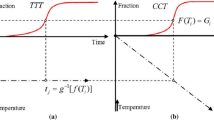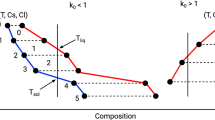Summary
Descriptions of the processes of crystallization and cooling of a planar intrusion body and its environs are compared by applying the frequently used Jaeger-Carslaw, adjusted Feoktistov-Feoktistova nad modified Lovering methods.
These comparisons indicate that the mathematical complications of the Feoktistov-Feoktistova method are outweighted by its better accuracy as well as by the fact that the process of computation is the same for any time and any ratio of thermal properties of lava and neighbouring rocks.
The comparisons imply that for dimensionless time, τ≳0.7, the modified Lovering method can be practically used also in the close surroundings of the contact.
Similar content being viewed by others
References
J. Bochníček: Der Einfluss der geometrischen Form und des Erkaltungsregimes auf den Verlauf der Magnetisation innerhalb einiger geologischer Gebilde. Általános Föltani Szemle, Budapest 1983.
J. Bochníček, P. Hejda: Cooling Rate of a Vertical Intrusion. Physical Properties of the Mineral System of the Earth's Interior. CAPG Project 3. Czechoslovak Academy of Sciences Geophysical Institute Prague 1985.
T. S. Lovering: Heat Conduction in Dissimilar Rocks and the Use of Thermal Models. Bull. Geol. Soc. Am., Vol. 47, 1936, 249.
J. C. Jaeger: The Temperature in the Neighborhood of a Cooling Intrusive Sheet. Am. Jour. Sci., Vol. 255, 1957, 306.
J. C. Jaeger: Temperatures Outside a Cooling Intrusive Sheet. Am. Jour. Sci., Vol. 257, 1959, 44.
H. S. Carslaw, J. C. Jaeger: Conduction of Heat in Solids. 2nd ed., Oxford University Press, New York, 1959.
J. C. Jaeger: Thermal Effects of Intrusions. Rev. Geoph., Vol. 2, 1964, 443.
T. S. Lovering: Temperatures in and Near Intrusions. Econ. Geol., Vol. 50, 1955, 249.
K. L. Buchan, E. J. Schwarz, D. T. A. Symons, M. Stupavsky: Remanent Magnetisation in the Contact Zone Between Columbia Plateau Flows and Feeder Dikes: Evidence for Groundwater Layer at Time of Intrusion. JGR, Vol. 85, 1980, 1888.
E. J. Schwarz, K. L. Buchan, A. Cazavant: Post-Aphebian Uplift Deduced from Remanent Magnetisation, Yellowknife Area of Slave Province. Can. J. Earth, Vol. 22, 1985, 1793.
Г. Д. Феоктистов, М. Ф. Феоктистова: О влиянии скрытой теплоты кристaлизации на температуриое поле вблизи пластовых интрузий трaппов. — В кн.: Математические методы в петрологии и геохимии. Москва „Наука“, 1970.
E. S. Larsen: Time Required for the Crystallization of the Great Batholith of Southern and Lower California. Am. Jour. Sci., Vol. 243, 1945, 399.
Таблицы физических величин, Москва, Атомиздат, 1976.
J. Schön: Petrophysik. Physikalische Eigenschaften von Gesteinen und Mineralen. F. Enke Verlag, Stuttgart, 1983.
P. H. Price, M. R. Slack: The Effect of Latent Heat on Numerical Solutions of the Heat Flow Equation. British Jour. Applied Physics, Vol. 5, 1954, 285.
Author information
Authors and Affiliations
Rights and permissions
About this article
Cite this article
Bochníček, J., Hejda, P. Cooling of a 2-dimensional intrusion. Stud Geophys Geod 33, 254–267 (1989). https://doi.org/10.1007/BF01633529
Received:
Published:
Issue Date:
DOI: https://doi.org/10.1007/BF01633529




